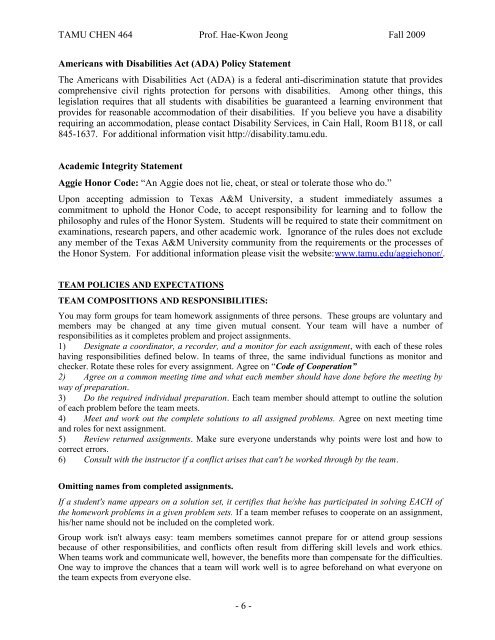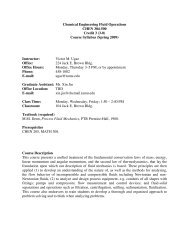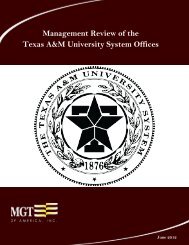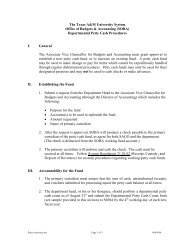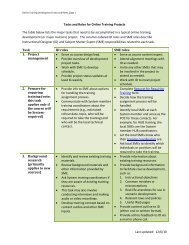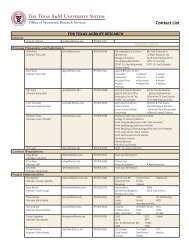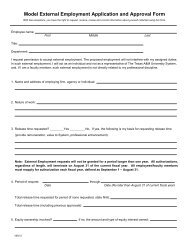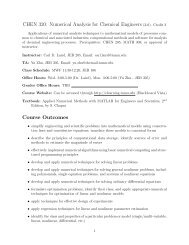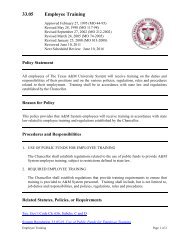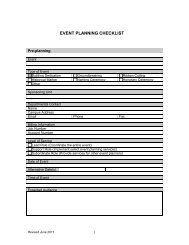CHEN 464 - Department of Chemical Engineering - Texas A&M ...
CHEN 464 - Department of Chemical Engineering - Texas A&M ...
CHEN 464 - Department of Chemical Engineering - Texas A&M ...
Create successful ePaper yourself
Turn your PDF publications into a flip-book with our unique Google optimized e-Paper software.
TAMU <strong>CHEN</strong> <strong>464</strong> Pr<strong>of</strong>. Hae-Kwon Jeong Fall 2009Americans with Disabilities Act (ADA) Policy StatementThe Americans with Disabilities Act (ADA) is a federal anti-discrimination statute that providescomprehensive civil rights protection for persons with disabilities. Among other things, thislegislation requires that all students with disabilities be guaranteed a learning environment thatprovides for reasonable accommodation <strong>of</strong> their disabilities. If you believe you have a disabilityrequiring an accommodation, please contact Disability Services, in Cain Hall, Room B118, or call845-1637. For additional information visit http://disability.tamu.edu.Academic Integrity StatementAggie Honor Code: “An Aggie does not lie, cheat, or steal or tolerate those who do.”Upon accepting admission to <strong>Texas</strong> A&M University, a student immediately assumes acommitment to uphold the Honor Code, to accept responsibility for learning and to follow thephilosophy and rules <strong>of</strong> the Honor System. Students will be required to state their commitment onexaminations, research papers, and other academic work. Ignorance <strong>of</strong> the rules does not excludeany member <strong>of</strong> the <strong>Texas</strong> A&M University community from the requirements or the processes <strong>of</strong>the Honor System. For additional information please visit the website:www.tamu.edu/aggiehonor/.TEAM POLICIES AND EXPECTATIONSTEAM COMPOSITIONS AND RESPONSIBILITIES:You may form groups for team homework assignments <strong>of</strong> three persons. These groups are voluntary andmembers may be changed at any time given mutual consent. Your team will have a number <strong>of</strong>responsibilities as it completes problem and project assignments.1) Designate a coordinator, a recorder, and a monitor for each assignment, with each <strong>of</strong> these roleshaving responsibilities defined below. In teams <strong>of</strong> three, the same individual functions as monitor andchecker. Rotate these roles for every assignment. Agree on “Code <strong>of</strong> Cooperation”2) Agree on a common meeting time and what each member should have done before the meeting byway <strong>of</strong> preparation.3) Do the required individual preparation. Each team member should attempt to outline the solution<strong>of</strong> each problem before the team meets.4) Meet and work out the complete solutions to all assigned problems. Agree on next meeting timeand roles for next assignment.5) Review returned assignments. Make sure everyone understands why points were lost and how tocorrect errors.6) Consult with the instructor if a conflict arises that can't be worked through by the team.Omitting names from completed assignments.If a student's name appears on a solution set, it certifies that he/she has participated in solving EACH <strong>of</strong>the homework problems in a given problem sets. If a team member refuses to cooperate on an assignment,his/her name should not be included on the completed work.Group work isn't always easy: team members sometimes cannot prepare for or attend group sessionsbecause <strong>of</strong> other responsibilities, and conflicts <strong>of</strong>ten result from differing skill levels and work ethics.When teams work and communicate well, however, the benefits more than compensate for the difficulties.One way to improve the chances that a team will work well is to agree beforehand on what everyone onthe team expects from everyone else.- 6 -


